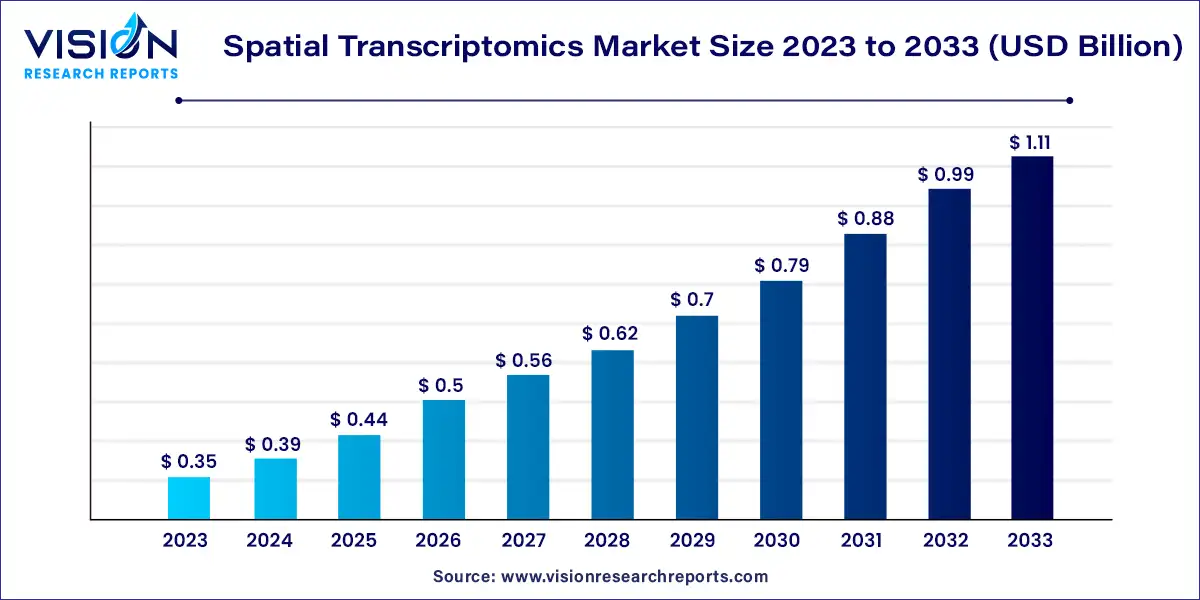The global spatial transcriptomics market size was estimated at around USD 0.35 billion in 2023 and it is projected to hit around USD 1.11 billion by 2033, growing at a CAGR of 15.25% from 2024 to 2033.

Key Pointers
- North America dominated the market with the largest market share of 58% in 2023.
- Asia Pacific estimated to expand the fastest CAGR of 16.94% from 2024 to 2033.
- By Product, the consumables segment generated the maximum market share of 53% in 2023.
- By Technology, the sequencing-based methods segment accounted for 54% of the market share in 2023 and is poised to register the highest CAGR from 2024 to 2033.
- By Workflow, the instrumental analysis segment contributed the largest market share of 48% in 2023.
- By Sample Type, the fresh frozen segment is expected to expand at the highest CAGR of 16.85% from 2024 to 2033.
- By End-use, the translational research captured the maximum market share of 57% in 2023.
Spatial transcriptomics involves the simultaneous measurement of gene expression levels and spatial coordinates within tissue samples. This technology provides researchers with valuable insights into the spatial organization of cells and their gene expression patterns, allowing for a deeper understanding of biological processes.
Get a Sample@ https://www.visionresearchreports.com/report/sample/41398
The Rise of Spatial Transcriptomics
1. Defining Spatial Transcriptomics (H2)
Spatial transcriptomics refers to the mapping of gene expression within the context of tissue architecture, providing spatially resolved information on RNA molecules.
2. Evolution of Spatial Transcriptomics (H2)
The field has evolved from traditional bulk RNA sequencing methods to spatially resolved techniques, enabling the interrogation of gene expression patterns within their native tissue microenvironments.
Drivers of Spatial Transcriptomics Market:
- Advancements in Spatial Genomics Techniques: Continuous innovations in spatial genomics technologies such as spatial transcriptomics have propelled market growth. These advancements enable researchers to analyze gene expression within tissue samples with spatial resolution, facilitating deeper insights into complex biological systems.
- Rising Demand for Personalized Medicine: The increasing demand for personalized medicine has fueled the adoption of spatial transcriptomics. By providing spatially resolved gene expression data, this technology enhances understanding of disease heterogeneity and aids in the development of targeted therapies tailored to individual patients.
- Growing Application in Drug Discovery and Development: Spatial transcriptomics offers valuable insights into the spatial organization of cells within tissues, aiding drug discovery and development processes. By enabling researchers to study gene expression patterns within their native tissue microenvironments, this technology accelerates target identification, validation, and biomarker discovery.
Challenges Facing Spatial Transcriptomics Market:
- Data Analysis Complexity: The analysis of spatial transcriptomics data involves complex computational methods and bioinformatics tools. Dealing with large datasets and extracting meaningful insights pose significant challenges, requiring expertise in both computational biology and statistics.
- Standardization and Reproducibility: Ensuring the standardization and reproducibility of spatial transcriptomics assays remains a challenge. Variability in sample preparation, experimental protocols, and data analysis pipelines can impact the reliability and comparability of results across studies and platforms.
- Cost and Accessibility: The initial cost of adopting spatial transcriptomics technologies, including instrumentation and reagents, can be prohibitive for some research labs and institutions. Additionally, accessibility to specialized expertise and infrastructure for conducting spatial transcriptomics experiments may limit widespread adoption, particularly in resource-constrained settings.
Opportunities in Spatial Transcriptomics Market:
- Expansion into Clinical Applications: There is significant potential for the expansion of spatial transcriptomics into clinical applications, including diagnostic testing, prognostic assessment, and therapeutic monitoring. Integration of spatially resolved gene expression profiling into clinical workflows could revolutionize precision medicine and improve patient outcomes.
- Technological Innovations and Platform Development: Ongoing technological innovations aimed at improving the sensitivity, throughput, and spatial resolution of spatial transcriptomics platforms present lucrative opportunities for market growth. Continued investment in R&D efforts focused on developing novel assays, instrumentation, and analysis tools will drive further market expansion.
- Collaboration and Partnerships: Collaborative initiatives between academic research institutions, biotechnology companies, and pharmaceutical firms can accelerate the translation of spatial transcriptomics discoveries into clinical applications. Strategic partnerships for co-development, validation, and commercialization of spatial transcriptomics-based products and services can unlock new avenues for market growth and differentiation.
Read More@ https://www.heathcareinsights.com/europe-viral-vector-and-plasmid-dna-manufacturing-market-2/
Spatial Transcriptomics Market Key Companies
- Illumina, Inc.
- NanoString Technologies, Inc.
- 10x Genomics.
- Cantata Bio
- Bruker
- EVOSEP
- Shimadzu Corporation
- Waters
- Horizon Discovery Group plc
- Bio-Techne
Spatial Transcriptomics Market Segmentation:
By Product
- Instruments
- By Mode
- Automated
- Semi-automated
- Manual
- By Type
- Sequencing Platforms
- IHC
- Microscopy
- Flow Cytometry
- Mass Spectrometry
- Others
- By Mode
- Consumables
- Software
- Bioinformatics Tools
- Imaging Tools
- Storage And Management Databases
By Technology
- Sequencing-based Methods
- Laser Capture Microdissection (LCM)
- Transcriptome In-Vivo Analysis (TIVA)
- In Situ Sequencing
- Microtomy Sequencing
- IHC
- Microscopy-based RNA Imaging Techniques
- Single Molecule RNA Fluorescence In-Situ Hybridization (smFISH)
- Padlock Probes/ Rolling Circle Amplification
- Branched DNA Probes
By Workflow
- Sample Preparation
- Instrumental Analysis
- Data Analysis
By Sample Type
- FFPE
- Fresh Frozen
By End-use
- Translational Research
- Academic Customers
- Diagnostic Customers
- Pharmaceutical Manufacturer
By Region
- North America
- Europe
- Asia Pacific
- Latin America
- Middle East and Africa (MEA)
Buy this Premium Research Report@ https://www.visionresearchreports.com/report/checkout/41398
You can place an order or ask any questions, please feel free to contact sales@visionresearchreports.com| +1 650-460-3308
